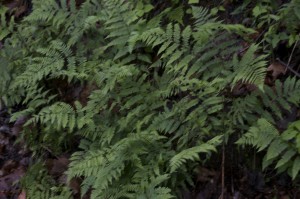My friend Dorothy and I just returned from four days in Gatlinburg for our second experience at the Wildflower Pilgrimage. With two hikes a day, one before lunch and one in the afternoon, we were able to walk with botanists, college professors, professional photographers, ecologists, and many experienced wild flower enthusiasts. As we walked, our guides pointed out specific plants and gave us some information about them. We saw trilliums of all kinds, Bishop’s Cap, tiarella, Solomon’s Plume, Solomon’s Seal, pink and yellow Lady’s Slippers, and countless others. We walked a couple of miles at over 5000 feet elevation along the Appalachian Trail. On the Chestnut Top Trail we walked along a steep ridge just wide enough for single file hikers. As we waded streams, climbed over large fallen logs and huge boulders, we were overwhelmed with the beauty of the mountains. We prowled around the forest at night hoping to catch a glance at owls as they flew overhead. Nothing can prepare you for the beautiful sights along the trails, the cascading waters of the many streams in the Blue Ridge Mountains, the waterfalls, and the pure joy of taking a ‘forest bath’ each day.
I’ve been gardening most of my life, and have never enjoyed the world of plants with as much enthusiasm as I have for these natives. I am slowly removing my non native trees, shrubs and flowers and replacing them with natives- more useable nectar for the pollinators, more digestible leaves for our many insects, which in turn provide more food for our birds and their babies. And once established, native plants require very little human intervention-after all, nobody goes into the woods to water and fertilize the native plants there. As a result of my changing my gardening focus, I’ve seen an increase in the number and variety of birds in the yard, as well as a greater influx of pollinators, especially the native bees which are the most efficient pollinators of all our insects.
It’s hard to believe that I’ve learned so much about these plants in less than 6 years. Much of that knowledge comes from attending rescues of native plants that are in danger of being destroyed by development. Walking through the woods with experienced native plant people is the best education you can get! If you want to learn more about how to identify native plants, why they are so important, and how you can help save them, get connected with the native plant society near you.
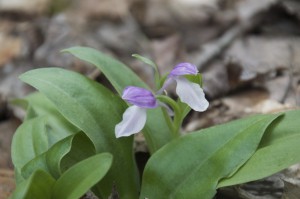
The showy orchid, Galearis spectabilis, is such a lovely native plant and seems to be quite common on several of the hiking trails.
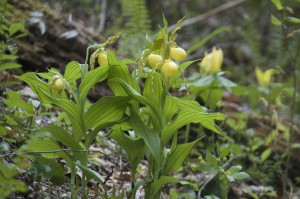
Yellow Lady’s Slippers are a joy to see. They sit perched high on the hillsides, just begging to be noticed.

This Dwarf Crested Iris, Iris cristata, is the darkest purple I’ve ever seen on the little beauties.
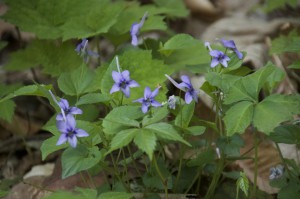
There must have been a dozen different kinds of violets on the trails, but I think this was probably the most prevalent-the long spurred violet-Viola rostrata.
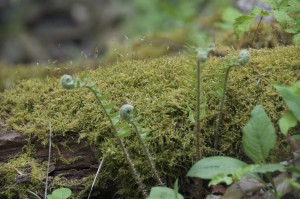
We took one hike that focused solely on native ferns. Of the nineteen kinds found in the Smokies, we saw 16, with lots of information to help us distinguish between the different ferns. These are the fiddleheads of the native Christmas fern. I understand that some fiddleheads are served boiled, broiled, baked, or batter-fried and are quite tasty. Don’t think I’d sacrifice any of my fiddle heads for that though.

Tiarella cardifolia, or foamflower, is one of the most common flowers in bloom on the trails right now. This is one of my favorite natives-long bloom time, easily adapts to many habitats, and just darn pretty.
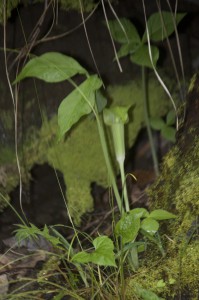
Everyone always gets excited when they spot a Jack in the Pulpit in bloom. The Arisaema triphyllum is a beautiful little plant.

This mixture of ferns, Phacelia and Mayapples was just one of many combinations that Mother Nature designed.
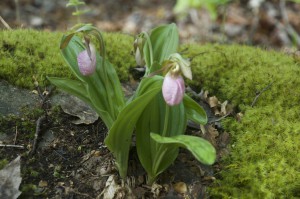
This pretty little pink Lady’s Slipper was growing in a crevice of a large rock. I found out later that the indention was made when someone tried to steal the orchid, but left enough roots behind for it to regenerate and regrow. What a shame there are such selfish people who can’t take a picture and leave the plants for others to enjoy.
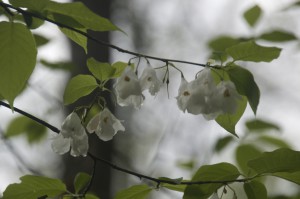
The lovely Silverbells, Halesia tetraptera; formerly H. carolina, was blooming along the roadsides almost to the point of being invasive. But I say, ‘Hey let a few invade my yard.’ (which they did last year following a rescue in Sand Hill)
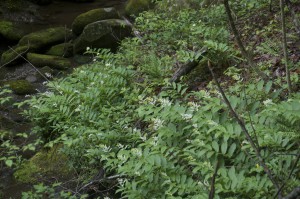
Solomon’s Plume, sometimes called False Solomon’s Seal, cascades down the steep hillsides from the trail to the stream far below. One of the most striking of our natives that blooms in spring, it is pretty even when not in bloom.
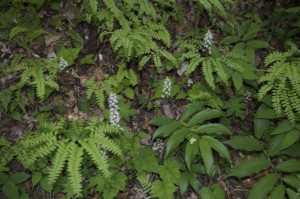
This Maidenhair Fern is the perfect compliment to the Tiarella and the Solomon’s Plume. White it looks very delicate, the Maidenhair is actually very hearty.
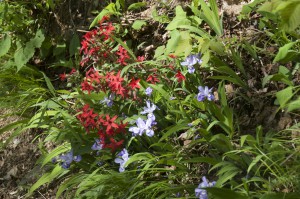
I have coveted the Fire Pinks since my Pilgrimage last year, and finally found some for sale at a recent plant sale. It will be a while before mine look like this, but I’m patient. Growing here with the pretty little crested Iris, it is a standout.

Hillsides were covered with this pretty Phacelia, or Scorpionweed as it is commonly known. If you can’t make it to the Smokies for the Pilgrimage, make a trip to the Pocket up in extreme Northwest Georgia in spring and you’ll be blown away by the abundance and beauty of t his plant. One of these found its way into my garden last year.
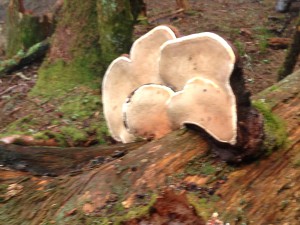
Fallen trees remain on the forest floor to rot away and provide nutrients for the living trees. Lichens and mosses love these dead trees. This lichen was on a fallen hemlock along the Appalachian Trail near Indian Gap.
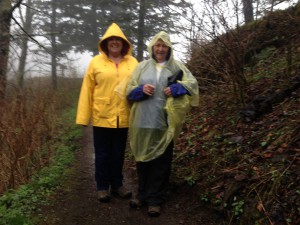
Dorothy and I can now claim to be hikers of the Appalachian Trail, even if it was only a couple of miles!
WATCH FOR POSTS ABOUT THE 2017 PILGRIMAGE ON THE WEB PAGE OF THE WEST GEORGIA CHAPTER OF THE GNPS. REGISTRATION IS IN MARCH WITH THE PILGRIMAGE IN APRIL. IT’S AN EXPERIENCE YOU’LL NEVER FORGET.

